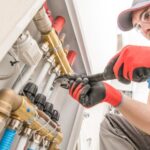A natural and economical option that is especially well-suited for cooling indoor spaces are evaporative cooling methods, particularly in areas with arid climates. Evaporative coolers utilize the natural process of water evaporation to effectively chill air, in contrast to traditional air conditioning systems that rely on compressors and refrigerants.
By doing away with the need for dangerous chemicals and cutting greenhouse gas emissions, this environmentally friendly method not only lowers the impact on the environment but also saves energy usage.
Principles of Evaporative Cooling
Evaporative cooling system works on the principle of evaporation, where water absorbs heat from the air as it evaporates. The process begins with water being circulated over a cooling pad or medium, typically made of cellulose or synthetic materials. A fan draws warm air from outside through the wet cooling pads, causing the water to evaporate and cool the air. The cooled air is then distributed into the indoor space through ducts or vents, while warm air is expelled outside.

Key Components of Evaporative Cooling Methods
- Cooling Pads: These pads or media are designed to absorb water and facilitate efficient evaporation. They are placed in front of the air intake of the evaporative cooler and are kept wet by a water distribution system.
- Water Pump: A pump circulates water from a reservoir onto the cooling pads, ensuring they remain saturated for effective cooling.
- Fan: The fan draws warm air from outside through the wet cooling pads. As the air passes through, it is cooled by the evaporation process and then circulated into the indoor space.
- Ventilation System: Evaporative coolers require adequate ventilation to expel warm air and maintain airflow balance.
Advantages:
- Energy Efficiency: Evaporative cooling approach consume significantly less energy compared to traditional air conditioning units because they do not require compressors or refrigerants. They utilize the natural process of evaporation, which is energy-efficient and environmentally friendly.
- Cost-Effectiveness: Lower energy consumption translates into reduced operational costs for homeowners and businesses, making evaporative cooling an economical choice for cooling large spaces.
- Environmentally Friendly: Evaporative cooling technique have a minimal environmental footprint since they do not emit greenhouse gases or use chemicals like refrigerants. They rely on natural water evaporation and air circulation to cool indoor spaces.
- Humidity Control: Unlike traditional air conditioners, which can dry out indoor air, evaporative coolers add moisture to the air during the cooling process. This can be beneficial in dry climates where humidity levels are typically low.
- Effective Cooling in Dry Climates: Evaporative coolers are particularly effective in arid or semi-arid regions where humidity levels are low. They provide efficient cooling by harnessing the natural cooling properties of water evaporation.

Considerations for Installation and Maintenance
- Climate Suitability: Dry, low-humidity environments are ideal for evaporative coolers to function at their best. Their cooling effectiveness may be diminished in humid locations because of the air’s already high moisture content.
- Water Quality: The quality of water used in evaporative coolers is important for maintaining system performance and longevity. Regular maintenance, including cleaning and changing cooling pads, is necessary to prevent mineral buildup and ensure optimal cooling efficiency.
- Airflow Requirements: Proper ventilation and airflow management are essential for effective operation of evaporative cooling methods. Adequate ventilation ensures efficient exchange of air and maintains indoor air quality.
Evaporative cooling methods offer a natural and energy-efficient alternative to traditional air conditioning, providing effective cooling solutions in dry climates while minimizing environmental impact. By harnessing the power of water evaporation, these systems enhance indoor comfort, reduce energy consumption, and offer cost-effective cooling solutions for residential, commercial, and industrial applications. As technology and environmental awareness continue to evolve, evaporative cooling remains a sustainable choice for achieving comfortable indoor environments with minimal ecological footprint.















